The “Club des Cinglés du Ventoux” translates into English as the Mont Ventoux Crazy Club!
You become a member by cycling the three roads up Mont Ventoux within a 24 hour period (and completing the necessary application). That’s 137 kilometres and 4,400 metres of ascent in a day. Cycling Mont Ventoux once is hard and requires a good degree of fitness, so the Cinglés du Mont Ventoux is not something to be undertaken lightly.
When Epic Road Rides reader Ben Davies (of Velomoho) got in touch to say that he was planning to take on the Cinglés challenge, we asked him to tell us all about it. He kindly agreed and in this article he shares his experiences of his Ventoux challenge, including tips on logistics, kit and cafe stops.
If you’ve ever wondered what the Cinglés du Ventoux is all about, read on for Ben’s tips on how to conquer it!
1. Tell us about the Cinglés du Ventoux – what and where is it?
Mont Ventoux is a mountain in the Provence region of Southern France, located around 20 km (12 miles) northeast of Carpentras.
At 1,909m (6,263 ft), or sometimes 1,911m, it is the highest mountain in the region and has many nicknames – the “Beast of Provence”, the “Giant of Provence”, or “The Bald or Windy Mountain”.
As the name suggests (venteux means windy in French), it can get extremely windy at the summit with wind speeds as high as 320 km/h (200 mph) having been recorded. The wind blows at over 90 km/h (56 mph) for 240 days a year.
You can find out more about climbing Mont Ventoux in our Ventoux guide here.
The “Cinglés” Ventoux challenge is organised by a French “club”, which is really a website called the Club des Cinglés du Mont Ventoux. The specific challenge set down by the Cingle du Ventoux is to attempt the three road ascents of Mont Ventoux within a 24 hour period (midnight to midnight). You need to get a 20 euro brevit card from them in advance to record your attempt.
There more on the brevit card here and more on the three routes up Ventoux below.
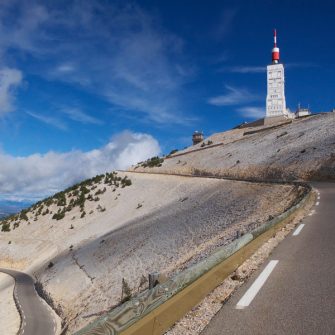 The mighty Mont Ventoux
The mighty Mont Ventoux Views above Chalet Liotard on the Malaucène side
Views above Chalet Liotard on the Malaucène sideOur Cinglés du Ventoux route
You can choose whichever sequence you wish to complete the challenge.
We followed the popular option of starting in Bédoin, descending to Malaucene, climbing up from there for the second ascent, descending to Sault and then riding Mont Ventoux from Sault for the third attack on Ventoux. This means we completed the two most difficult climbs first, leaving tired legs for the (relatively) easier ascent from Sault.
Cinglés GPX file and statistics
Here is my Strava link for the cycle Ventoux challenge day. {Note: sorry, this is no longer working – we’re working on getting an updated link!]
2. What prompted you to take on this Mont Ventoux cycling challenge?
I had heard of the Cingle Mont Ventoux challenge but not thought a great deal about it, thinking it was out of my reach/ability.
However, while on a cycling trip in France in March 2020, my friend Richard said he already had his “brevit card” (needed to collect stamps and authenticate your attempt – more on this later) – and this led to us hatching a plan to attempt the Cinglés du Ventoux together.
March 2020: attempt #1 aborted
During our March 2020 trip to France, we decided to call in on Ventoux on the way back from Nice and see if we could squeeze in a Cinglés during the early season.
On the day of our March attempt, the weather was partially favourable, with light winds and sunshine. However, we discovered after our first climb that the Malaucène side was totally blocked with ice! On the Bédoin side there had just been smatterings of snow (as per the photos below).
We continued back down to Sault before climbing to the summit once again then descending dejectedly to Bédoin where we spent the evening in a local bar.
That very night France went into lockdown, which forced us to rethink our itinerary.
The next day we rode a circular tour around the base of the mountain then climbed from Malaucène to within 3 kilometres of the summit, just to make sure that the ice was actually blocking the road – it was!
That evening we headed slightly north and then decided the next day to return immediately to the UK following Government advice and a mad dash to Calais ensued.
 Snow in mid March on the Bedoin side
Snow in mid March on the Bedoin side Looking from the summit back towards Bédoin (spot the snow!)
Looking from the summit back towards Bédoin (spot the snow!)July 2020: attempt #2
Roll forward four months to July and after all the curtailments in the UK and a distinct lack of decent weather, I dropped the guys a message asking if anyone fancied some time away again, not expecting the answers I received.
Within a few days we were embarking on a ferry in Dover and heading south to Ventoux once again!
3. Tell us what each climb was like.
The three routes for cycling up Ventoux are as follows:
South from Bédoin
1,617 m (5,305 ft) over 21.8 km (13.5 mi). This is regarded as the most difficult climb up Mt Ventoux and is also the most popular side. The road to the summit has an average gradient of 7.43% and a maximum gradient of 10%.
By way of comparison, the climb of Alpe d’Huez is about 13.8 km (8.6 miles) at an average gradient of 7.9%.
At the time of writing, the Strava KOM on this segment was recently taken by Joshua Dubau on 20th July 2020 with a time of 1:00:56!
Much of the lower parts of the Bédoin ascent are in forest, which offers a good deal of cover during the heat of summer.
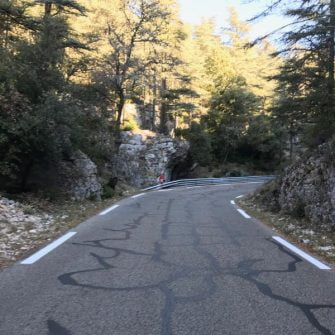 In the forest on the way up from Bédoin
In the forest on the way up from Bédoin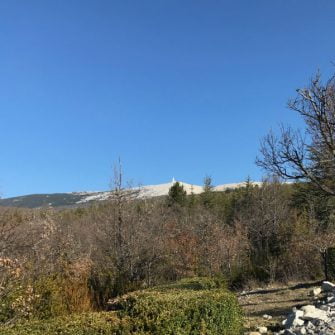 First view of the Ventoux prize!
First view of the Ventoux prize!Rare glimpses of the summit beckon you upwards towards Chalet Reynard and (if it’s open) some sustenance.
After Chalet Reynard there is no cover at all from the elements. Baking heat during the summer and freezing temperatures during the winter months often leave the summit inaccessible. Our March attempt had signs showing “Route Barree” (Road Closed) after Chalet Reynard, though this was for motor vehicles as the road had a barrier across. We picked our way carefully over the snow and ice which was still left in patches, though passable on the Bédoin side.
More info on the Bedoin route up Ventoux here.
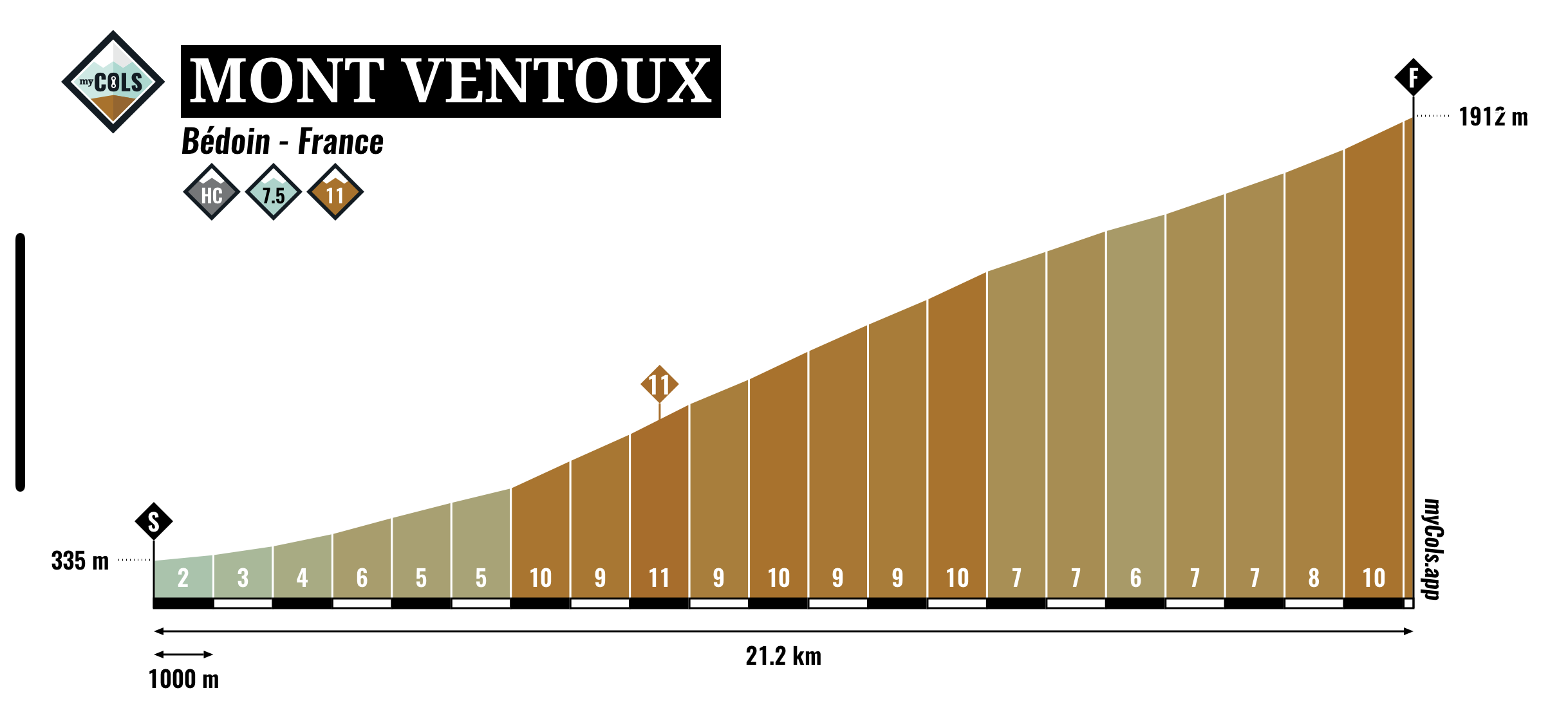 Via the MyCols app
Via the MyCols appNorthwest from Malaucène
1,570 m (5,150 ft) over 21.5 km (13.4 miles). About equal in difficulty as the Bédoin ascent, but better sheltered against the wind, this ascent of Ventoux is at an average gradient of 7.2% and a maximum gradient of 10.5%.
The Malaucène side is very picturesque as it overlooks the mountains in the distance. It is also a fast, superb descent.
Approximately 5 kilometres from the top is Chalet Liotard (which may not be open depending on the time of year).
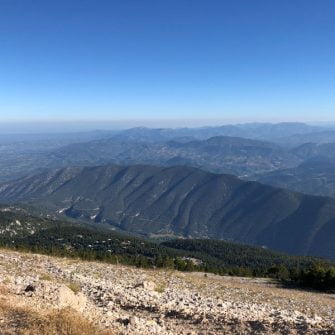 View down towards Malaucène from Ventoux
View down towards Malaucène from Ventoux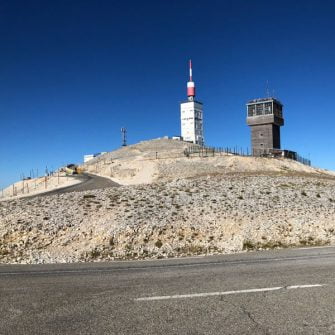 Mont Ventoux summit from the Malaucène side
Mont Ventoux summit from the Malaucène sideA quick turn around in Malaucène and we headed back up towards the summit for the second of the three ascents. Luckily the sky remained overcast preventing the searing summer sun burning us to a crisp, though we felt this side was a little more sheltered than Bédoin.
The final section of the climb from Malaucène up to the tower itself is one that not many people see or bother to look for as it’s not on the most popular side, though it is very interesting as you approach the towers.
More info on the Malaucene route up Ventoux here.
 Via the MyCols app
Via the MyCols appEast from Sault
1,210 m (3,970 ft) over 26 km (16 miles). This is the easiest route with an average gradient of 4.4%. After Chalet Reynard the climb follows the same route as the Bédoin ascent.
More info on the Sault route up Ventoux here.
 Via the MyCols app
Via the MyCols app4. If you had to pick your favourite route up, which would it be and why?
Peter Ramsden: Malaucène because of the views.
Richard Bligh Smith: Bédoin because of the last 6 kilometres in the lunar landscape.
Me: Though the views really are spectacular from the Malaucène side, I still enjoy the Bédoin side and the ride past the Tommy Simpson memorial is always special.
 Incredible views on the Malaucène side of the Ventoux climb
Incredible views on the Malaucène side of the Ventoux climb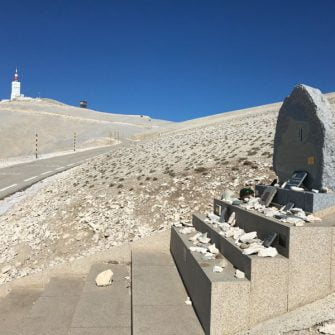 Tom Simpson memorial on Ventoux
Tom Simpson memorial on Ventoux5. What were the best and worst things about the Cinglés du Ventoux?
The best thing for us on our July attempt, was the fact that the Malaucène side was open. It was a relief to be able to at least attempt the challenge!
The overcast sky was also a relief, keeping us cool. Conversely, on our third ascent from Sault, the cloud cover had burnt away leaving us struggling not only with tired legs but also high temperatures through the lavender fields near Sault and again the final 6 kilometres from Chalet Reynard. Luckily the forecasted 50Kph winds didn’t materialise, though they did pick up a little in the afternoon.
It’s also worth noting that there are currently roadworks at the summit leaving little room for cyclists to actually crest the final 100 metres. This is particularly difficult during the summer months and in the early afternoon when the summit gets packed with visitors. If the works are still there when you visit, take care and maybe even unclip!
 Clear skies and sunshine – beautiful conditions for a Club club des Cinglés du Mont Ventoux attempt!
Clear skies and sunshine – beautiful conditions for a Club club des Cinglés du Mont Ventoux attempt!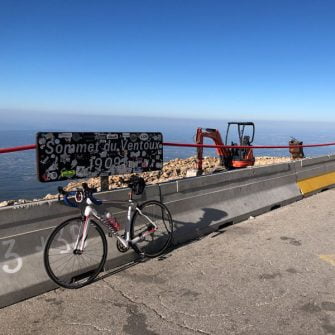 Roadworks at the top of Ventoux (July 2020)
Roadworks at the top of Ventoux (July 2020)6. How fit do you have to be to do it?
Fitness and pacing
Fitness should be a big consideration for this challenge. 85 miles coupled with 15,000 ft of climbing could easily be 9 hours in the saddle (see below for more info on this).
Stamina is important, as the climbs are long rather than steep, and there is also the mental element to take into consideration too. You must be in a positive frame of mind for when the going gets tough, which it does!
Pacing yourself is really important. Leaving everything on the first or second ascent and having nothing for the last leg is not the right way to go about this challenge.
Preparation
The main preparation we’d all done was lots of riding. We’re all lucky enough to live in Yorkshire where there are plenty of hills to get used to. We were all at a level where we could manage a hilly 100 mile ride in the Dales. (For more info on cycling in the Yorkshire Dales, check out the Epic Road Rides guide to Yorkshire!)
Preparation included good food the night before, with lots of fluids, large breakfasts before departure, again with lots of fluids and plenty of nutrition both carried and bought whilst out.
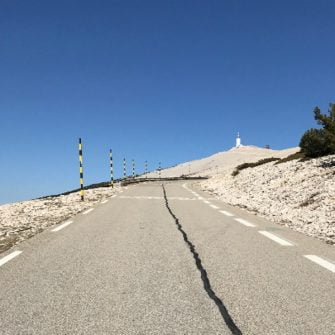 The final (hard) few kilometres from Bedoin are a real test of the legs (especially the third time up!)
The final (hard) few kilometres from Bedoin are a real test of the legs (especially the third time up!)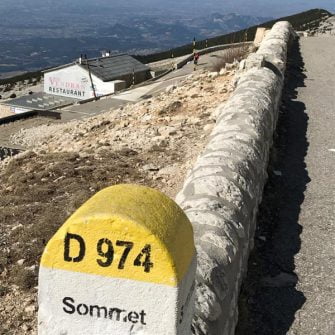 On the Bedoin side just before the roadworks (July 2020)
On the Bedoin side just before the roadworks (July 2020)7. What sort of logistics are involved in climbing Mt Ventoux?
Bike hire
Bike hire is available in both Bédoin and Malaucène, where there are also plenty of campsites, hotels etc. Most seem reasonably priced though will obviously increase during high season etc. (Our tips for hotels near Ventoux are here.)
Timings
Apparently the sunrise at the summit is spectacular. If you’re riding in summer, the benefits of setting off early are that you will miss the aggressive heat of the afternoon.
We departed around 06:00 and were back around 16:00, which worked out fine bearing in mind the final descent will normally be cooler and takes around 40 minutes.
Departing quite early meant our earlier ascents were not hampered by cars or other cyclists. Even though we rode on a Sunday, the roads were fairly quiet until closer to midday when the locals and sightseers came out.
Sheep
In the afternoon/evening be aware that the local shepherds may collect and move their flocks of sheep which wander aimlessly along the roads. We encountered this on our final descent, though luckily an ascending cyclist shouted a warning to us on a bend and we managed to slow down in time.
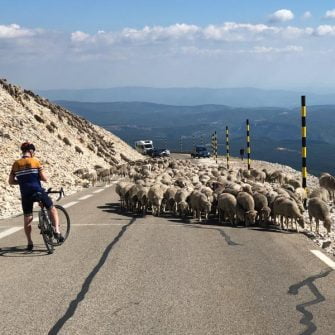 Watch out for sheep!
Watch out for sheep!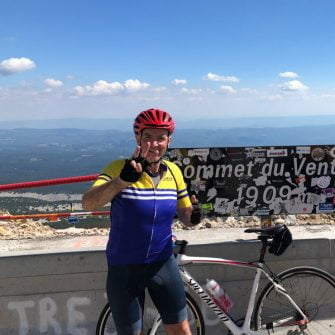 Ben at the summit having completed the three ascents
Ben at the summit having completed the three ascents8. Tell us about your kit choices for cycling Mt Ventoux. Anything you’d recommend taking/not taking?
Clothes
We found the early morning descents quite cool, even in July, so arm warmers and gilets are sensible, along with a lightweight jersey. Otherwise just ordinary basics such as mitts, bib shorts and cleats will suffice.
As a general rule, expect it to be 10° colder at the top of Ventoux than in the villages at the bottom. So for example if it’s 20° in Malaucène, it will be roughly 10° on the top and descending with some windchill will not be pleasant without arm warmers and a gilet.
If the weather isn’t looking favourable, and is in the region of 5° on the summit, we’d have gone for more clothes – a good quality long sleeved jersey, long finger gloves and leg warmers.
Gearing
We all rode different gear ratios, ranging from Peter with a 28, Richard on a 30 and me on a 32 which is the one my Specialized Roubaix came with. Peter will readily admit that he would have been better to have changed to at least a 30 tooth rear in hindsight.
Bottle cages
A top tip would be to fit a second bottle cage to your bike as you will undoubtedly need it and there’s not that many places to refill. Take two 750ml bottles and grab water while you can.
9. How did you organise your nutrition during the Ventoux challenge?
Saddle bags
We carried additional nutrition in backpacks and saddle bags, though tried not to weigh ourselves down with too much so really just essentials. For the early ascent we took cheese and ham wraps in case we were too early for any shops to be open.
Water fountains and cafe stops
There are water fountains in each of the three villages. There’s also a tap in the toilets at Chalet Reynard (and of course you can stock up at the cafe there and at Chalet Liotard, assuming they’re open). Drinks are also available from the gift shop on the summit if it is open.
If Chalet Reynard/Chalet Liotard are open they serve great hot food and cold drinks that cater towards cyclists. The towns also all have shops that will get you sustenance to your next stop and the tiny shop at the summit has basics. We ate our lunch at a pop up pizza bar in Sault.
We had pizza, flans, coke, sandwiches and chocolate bars from the shops/chalets as well as the gels, tablets and energy bars we carried ourselves along with extra water (2 bottles are a must have and can be refilled in towns, chalets and at the summit).
Other tips
We tried to drain everything we had when we reached a refuelling point before refilling bottles with (bought) water and taking food on from local cafés, sandwich shops, pizza bars etc along with a sugary drink like coke.
Remember to stash a few euros in cash in your pockets; cash is king in the mountains – especially at the summit shop where there is a minimum spend on cards.
 Refuelling at Chalet Reynard is a good plan
Refuelling at Chalet Reynard is a good plan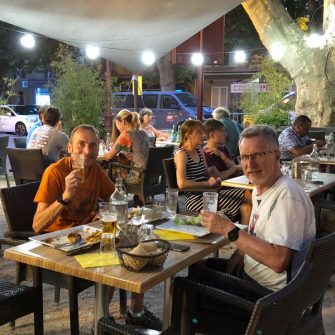 Celebrating having conquered the Cingles du Ventoux!
Celebrating having conquered the Cingles du Ventoux!10. What tips would you give to someone wanting to take on the Cinglés Mont Ventoux challenge?
When to go
Though we’d expect there to be more people on the roads at weekends (due to local cyclists riding Ventoux), in our experience there hasn’t been any noticeable difference in terms of the number of cars/cyclists on the road whether it’s been a weekend or weekday. However, remember that these are all open roads with plenty of traffic, so take care.
It’s also worth checking whether there are any sportives, races or motorsport events on before you set off, as the mountain is often used for such things. Club des Cinglés Facebook page and other local websites should help here. There is even a weather webcam in Bédoin.
Weather wise I would aim for late spring or early autumn to avoid the hottest days. July and August are very warm – though they do have the advantage of offering long hours of daylight, if you’re planning to take a while! It’s also worth noting that the official website states (in translation) “Do not schedule this trip either too early (before April) or too late (after October) at the risk of having certain surprises”.
How long does it take to do the Club des Cinglés?
It all depends how fit you are. Be realistic with yourself! The average is between 9 and 10 hours (we took around 10 hours). This breaks down as roughly 3 hours for each cycle up Mont Ventoux, descent and any breaks, plus 1 hour for lunch and photos etc.
Photographers
On the final stretches of the ascents, keep an eye out for the photographers. They will take some great pictures of you and hand you a card with their website details and the time of your pictures which makes it easy to find them when searching after your trip.
Brevit cards
We left it too late for two of our party to get brevit cards (note that the website states you need to register at least 15 days before the attempt (21 days during the holiday period)), but the Club Des Cinglés were very helpful, even offering to post them to the Bédoin or Malaucène Tourist Information or Post Office. Unfortunately this didn’t work for us, so after the event we contacted the Club des Cinglés and sent them our Strava links and the photos we took. This was acceptable to them and our certificates and medals arrived a couple of weeks later.
In terms of where to go to get the brevit card stamp, any cafe or bar should have a stamp. While we didn’t use them ourselves, we understand the best bets would be:
If you complete the challenge you’ll earn a medal and a certificate – but that’s not really the reason for doing it. This is not a sportive!
Want something even more daring than the Cinglés?
How about setting yourself the task of becoming a Galérien (183 kilometres with 6,020 metres of climbing). This requires you to ride up and down the three main roads and then up the Route Forestière (a dirt track for the middle 6 kilometres)!
Or you could take on the Bicinglette, which is the Cinglé – but twice. It requires six ascents and six descents – that’s 274 kilometres with 8,800 metres of climbing!
Food for thought?!
A big thanks to Ben for his very helpful article on the Cinglés du Ventoux. If you’d like to see more from Ben, check out his Velomoho YouTube channel and subscribe to follow his cycling adventures. Here’s the first part of his Cingles video to give you a taste – check out his channel for Parts 2 and 3 of this excellent series.
What’s next?
Don’t miss our guide to cycling Mont Ventoux, including Ventoux from Bedoin, Ventoux from Malaucene and Ventoux from Sault and our cycling Mont Ventoux tips.
For more guides to cycling in other regions of France, check out our cycling in France page or search by the month you want to travel on our destinations page.
Please support Epic Road Rides
A huge amount of time and effort goes into the article you’ve just read, all with the aim of helping you!
If you found what you’ve read useful, I’d really appreciate it if you dropped something in the tip jar here.
It’s a way you can say thank you and help us carry on creating top quality content with no annoying ads and no pay wall.
Looking for an organised cycling trip?
If you want someone to help you plan and book your cycling holiday, fill out this form. We aren’t a tour operator/agent but we work with lots of people who are and will do our best to put you in touch with someone that can help (within 24 hours wherever possible)!
The contents of this website are provided for general information purposes only. It is not intended to amount to advice and you should not rely on it. You should carry out your own due diligence and risk assessments and take professional advice. Views expressed by interviewees or other users of this website do not necessarily represent our views. We make no representations, warranties or guarantees, whether express or implied, that the content on our website is accurate, complete or up to date. If you use any information or content on this website, download from, or otherwise obtain content or services through our website, it is entirely at your own discretion and risk. Epic Road Rides Ltd disclaims all liability and responsibility arising from any reliance placed on the information and content on this website. Find out more here.


Great overview of an epic ride. Chapeau!
Really enjoyed reading on Ben Davies’ words on Mont Ventoux. Just digesting the information. As in, with two good friends, we will be riding Ventoux in mid-late August. The trip, having turned 50 in 2020, has been delayed for two years. I have mind, for the three of us, to do Les Cingles, whilst with this being a ‘first time’ experience of Mont Ventoux. Have been looking forward to this for so long, whilst knowing how ambitious this challenge will be. We’re only, as with many, only amateur cyclists but we certainly have the mind to want to meet this challenge head on. Something, from reading, is to know how best to both drink and eat during the cycle rides. Anyway, here’s to our efforts being a success.
Do you have a link to the route you followed?
Apologies, we can’t find it!